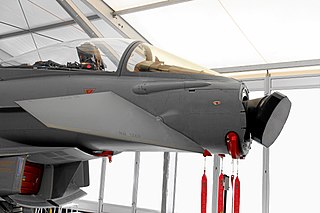
An active electronically scanned array (AESA) is a type of phased array antenna, which is a computer-controlled array antenna in which the beam of radio waves can be electronically steered to point in different directions without moving the antenna. In the AESA, each antenna element is connected to a small solid-state transmit/receive module (TRM) under the control of a computer, which performs the functions of a transmitter and/or receiver for the antenna. This contrasts with a passive electronically scanned array (PESA), in which all the antenna elements are connected to a single transmitter and/or receiver through phase shifters under the control of the computer. AESA's main use is in radar, and these are known as active phased array radar (APAR).

The Type 052C destroyer is a class of guided-missile destroyers in the Chinese People's Liberation Army Navy Surface Force (PLAN). The Type 052C introduced both fixed active electronically scanned array (AESA) radar and vertically launched surface-to-air missiles into PLAN service, making it the first Chinese warship with area air defence capability.

The Murasame-class destroyer is a class of destroyers, serving with the Japan Maritime Self-Defense Force (JMSDF). This is the first class of the second-generation general-purpose destroyers of the JMSDF.

The Asagiri-class destroyer is a class of destroyer, serving with the Japan Maritime Self-Defense Force (JMSDF). It was the second class of first-generation general-purpose destroyers of the JMSDF.

The Murasame-class destroyer was a destroyer class built for the Japan Maritime Self-Defense Force (JMSDF) in the late 1950s as a successor to the Ayanami-class destroyers. Like its predecessor, its main task was anti-submarine warfare, but its improved weaponry also enabled it to perform better in the anti-air role, so this class was classified as "DDA" unofficially.

The Isuzu class destroyer escort was a destroyer escort class built for the Japan Maritime Self-Defense Force (JMSDF) in the early 1960s. The latter batch were quite different from the earlier two vessels in their propulsion and weaponry, so sometimes they were classified as the "Kitakami class".
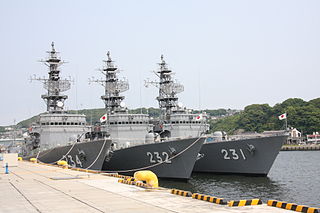
The Abukuma-class destroyer escort is the general-purpose destroyer escort of the Japan Maritime Self-Defense Force. It is the successor of the earlier Yūbari class.

The Akizuki class of destroyers of the Japan Maritime Self-Defense Force is intended to escort the Hyūga-class and Izumo-class helicopter destroyers, and safeguard the other Aegis-capable warships such as the Kongō class and Atago class. The destroyer provides defense against surface, airborne and undersea threats. The class was initially designated as "19DD", referring to a date on the Japanese calendar, specifically the 19th fiscal year of the Heisei period (2007).

The AN/SPY-6, also known as the Air and Missile Defense Radar(AMDR), is an active electronically scanned array 3D radar under development for the United States Navy (USN). It will provide integrated air and missile defense for Flight III Arleigh Burke-class destroyers. Variants are under development for retrofitting Flight IIA Arleigh Burkes and for installation aboard Constellation-class frigates, Gerald R. Ford-class aircraft carriers, and San Antonio-class amphibious transport docks.
The Type 052D destroyer is a class of guided-missile destroyers in the Chinese People's Liberation Army Navy. The Type 052D is a larger variant of the Type 052C; the Type 052D uses a canister-type, instead of revolver-type, vertical launching system (VLS) and has flat-panelled active electronically scanned array (AESA) radar. The new VLS is not limited to surface-to-air missiles, making the Type 052D China's first dedicated multi-role destroyer.

FCS-3 is an integrated naval weapons system developed by the Japanese Defense Ministry for the Japan Maritime Self-Defense Force.
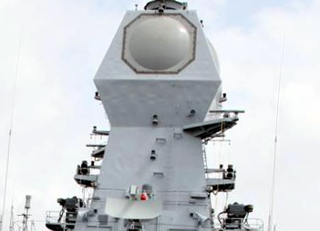
The EL/M-2248 MF-STAR is a multifunction active electronically scanned array naval radar system developed by IAI Elta for maritime installation on warships. It is capable of tracking both air and surface targets and providing fire control guidance. MF-STAR is an acronym of Multi-Function Surveillance, Track And Guidance Radar.

The Asahi class of destroyers of the Japan Maritime Self-Defense Force is optimized for undersea warfare. The class was initially designated "25DD", referring to a date on the Japanese calendar, specifically the 25th fiscal year of the Heisei period (2013).
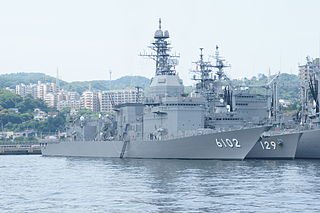
JS Asuka (ASE-6102) is an experimental ship of the Japan Maritime Self-Defense Force. The vessel was constructed by Sumitomo Heavy Industries of Tokyo, Japan and was launched on 21 June 1994. Asuka was commissioned on 22 March 1995 and since then has conducted performance confirmation tests for integrated navigation systems.

OPS-14 is a two-dimensional radar manufactured by Mitsubishi Electric. It is mainly mounted on the Maritime Self-Defense Force's self-defense ship as an anti-aircraft search radar. Variations include OPS-14B and OPS-14C.

OPS-11 is a two-dimensional radar manufactured by Mitsubishi Electric. It is installed as an anti-aircraft search radar on the Maritime Self-Defense Force's escort ship, and it will be the first model originally developed by Japan after World War II for this purpose. Variations include OPS-11B and OPS-11C.

OPS-18 is a two-dimensional radar manufactured by Japan Radio Company. It is installed as an anti-water search radar on the Maritime Self-Defense Force's escort ship. Variations include OPS-18-1 and OPS-18-3.
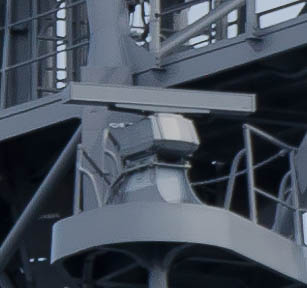
OPS-20 is a two-dimensional radar manufactured by Japan Radio. It is compatible with the Global Maritime Distress and Safety System (GMDSS) and installed as an anti-water search radar on the Maritime Self-Defense Force's escort ship. Variations include OPS-20B, OPS-20C and OPS-20E.

OPS-28 is a Pulse-Doppler radar manufactured by Japan Radio. It is installed as a low-altitude warning / anti-water search radar mainly on the Maritime Self-Defense Force's escort ship. Variations include OPS-28-1, OPS-28B, OPS-28C, OPS-28D, OPS-28E and OPS-28F.

AN/SPS-6 is a two-dimensional radar manufactured by Bendix and Westinghouse Electric. It was used by the US Navy as a first-generation air-search radar after World War II, and was widely exported to allies. In addition, the improved AN/SPS-12 is the derivative types developed in other countries.



















